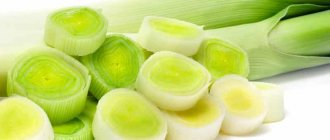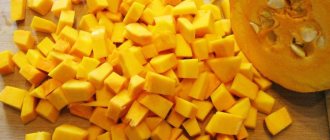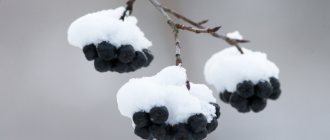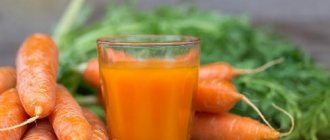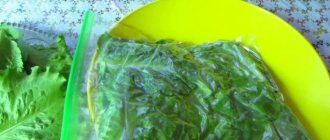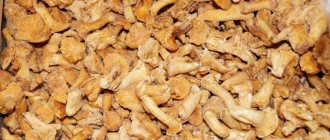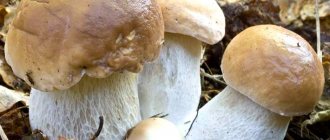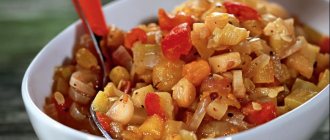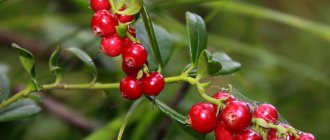Step-by-step recipe with photos
Freezing quince helps me out every year. I freeze quinces for the winter during the autumn season, when such hard yellow fruits are sold on almost every corner. For example, last year there were very few quinces and they were sold at an exorbitant price, but I had some left over from the year before and it really helped me out! For those who are not familiar with this fruit, I would like to say that it reveals its aroma and taste only after heat treatment - quince is not eaten fresh! More precisely, those who like the tart taste and dense stoneness of the fruit eat it, but that’s not about me.
I recommend freezing quince in baked and boiled form, but boiling it in syrup. I don’t make quince puree - it’s easy to create from baked frozen pieces after defrosting them at room temperature. The first option for freezing is made without sugar - I add these baked slices when cooking meat: pork, beef, chicken, lamb, etc. – the dishes turn out incredibly tasty! The second option, which is frozen in syrup, is suitable for creating the filling of pies, pies, drinks or lemonades.
So, get the necessary ingredients and let's start cooking!
There is a very thick fleecy layer on the surface of the quince - it needs to be washed off with water, scrubbing with the hard side of the sponge.
Then place half of the quince fruits in a baking dish and bake in the oven at 200°C for about 30-40 minutes.
Remove, cool and cut each fruit into four pieces. Remove seed blocks and cut into pieces.
Place the baked quince pieces in a bag, tie tightly, and place in the freezer.
Cut the remaining fruit into quarters and remove the seed blocks. Act very quickly, as quince pulp oxidizes when exposed to air and becomes rusty. Rinse the pulp and cut into slices.
Place them in a container, add granulated sugar.
Pour in warm water, add a slice of lemon or replace it with citric acid - 2 pinches.
Boil the quince slices in the syrup for about 20 minutes, being careful not to overcook them. Turn off the heat and cool. Pour into a container and freeze.
Freezing quince for the winter is completely completed. When needed, simply remove some of the frozen food and defrost at room temperature for 1-2 hours.
Quince: composition, beneficial properties, preparations for the winter
Greetings, dear readers!
Autumn is a fertile time, giving us an abundance of healing fruits. Quince is a woody plant of the Rosaceae family, growing in the Mediterranean countries, Asia, most of Europe, Ukraine, Belarus and Russia, as well as in both parts of America and Australia.
Quince bears fruit with yellow, spherical or pear-shaped false apples. Let's talk about the beneficial properties of quince
and its application.
The fruit pulp has a strong pleasant aroma and a hard structure with many stony cells. The taste of quince is sweetish and at the same time tart and astringent. Unlike related trees pear and apple trees, ripe fresh fruits are not suitable for consumption and are even considered harmful food for the intestines. But after culinary processing (compote, jam, jelly, marmalade), the pulp acquires an amazing sweet taste. Cool drinks are prepared from quince and used as a flavorful addition to meat dishes.
Composition of quince fruits
All parts of the plant - fruits, leaves, seeds, bark, young shoots, flowers are widely used in medical practice. Ripe fruits contain sugars, tannins, protopectin compounds, organic acids, fiber, antioxidants, essential oils, compounds of copper, iron, magnesium, phosphorus, potassium and calcium. The vitamin composition of quince is represented by beta-carotene, retinol, ascorbic acid, tocopherol, thiamine, riboflavin, and vitamin PP.
Useful properties of quince. Use in folk medicine
Traditional medicine doctors prescribe boiled grated fruits for liver diseases. If there are cracks in the anus and problems with rectal prolapse, lotions made from fruit pulp or juice are considered one of the most effective remedies. Tea made from seeds or pieces of fruit helps stop bleeding, including uterine bleeding.
Baked or boiled quince pulp is recommended to be used during the period of toxicosis in pregnant women as an antiemetic. The juice of the fruit has antiseptic and antibacterial properties; its inclusion in the diet is advisable for patients suffering from respiratory diseases, including bronchial asthma. Freshly squeezed quince juice is prescribed to drink for infertility, both female and male.
The diuretic and astringent properties of quince make it an indispensable product in the treatment of cystitis. The fruits are also useful for edema of cardiac and renal origin, pyelitis, nephrosis, nephritis. Due to the high content of iron and copper, the fruit is successfully used to treat anemia, especially in combination with buckwheat, forest, alpine or sunflower bee honey.
Quince has a choleretic, antimicrobial, hematopoietic, cleansing, antioxidant, antiulcer, tonic, and restorative effect on the body. The fruits are prescribed for food when the body is poisoned by heavy metals, since the cleansing properties of quince are much stronger than apricots. Since ancient times, diseases of the gastrointestinal tract have been healed with the help of fruits.
Quince preparations for the winter
The easiest way to preserve quince until the next harvest is to freeze it. Modern freezers have a very useful “Express Freezing” function, with which fruit slices are sharply cooled, preserving the maximum of nutrients in the pulp.
The fruits are washed with water, washing off the lint from the surface, dried on a kitchen towel, cut into 4 parts, the seed pods are removed, chopped into medium-sized cubes, placed in plastic bags, and the air is pumped out of them (this process can be carried out not only using a special device, but and a regular cocktail straw) and put it in the freezer, turning on the fast freezing mode.
Compotes, jelly, and jellies are prepared from such quince; it is boiled and baked for use for medicinal purposes all year round. Frozen quince is also an excellent seasoning for chicken. To prepare a spicy and appetizing bird with sourness according to the Uzbek recipe, it is coated with seasonings and salt (hot pepper or paprika, coriander and cumin seeds crushed into powder), stuffed with frozen quince cubes (in the absence of fresh fruit), wrapped in foil and sent to a heated to a temperature of 200°C oven for 1.5 hours.
Quince jam
For 3 kg of ripe fruit you will need 1.5 kg of granulated sugar, 0.6 liters of drinking water and a coffee spoon of citric acid.
The washed fruits are divided into 4 parts to remove the seeds and rocky layer, cut into beautiful slices, poured with syrup (dilute the sugar with water in an enamel pan and bring to a boil), and cook after boiling for a quarter of an hour. Cool the jam and repeat the cooking procedure 2 more times. 5 minutes before the end of cooking, add citric acid to the sweet mass. Hot jam is laid out in sterilized jars and covered with lids. The jam is stored at room temperature.
Not 4 kg of ripe quince, you will need 1.35 kg of sugar, 2 liters of water, 260 ml of table vinegar (9%), a pinch of vanilla powder.
Wash the fruits, cut into quarters, remove the seeds with a knife, cut into slices, place in a boiling marinade (sugar, water, vinegar, vanilla), boil for 10-12 minutes over low heat, remove the fruits with a slotted spoon and place in sterilized jars. Continue boiling the marinade until the volume is reduced by about half. Pour boiling liquid over the quince slices, sterilize the jars for 10 minutes and roll up the lids. Pickled quince is stored at room temperature or in the cellar.
Quince for the winter
Quince is a fragrant fruit known since ancient times. In legends and myths there is a mention of a golden apple. It was not by chance that quince received this name; in appearance it resembles a large yellow apple and a little bit of a pear. When fresh, the fruit is hard and can be enjoyed in various dishes. But the smell - a mixture of pineapple and roses - promotes mental relaxation.
The fruit grows in the Caucasus, Far East, and Asian territory. And in central Russia it is found only on store shelves. To have the opportunity to taste the golden apple as often as possible and to have its fragrant aroma on the table, you can prepare quince for the winter. There are many options for preparation, from freezing to jam.
Content:
Honey marshmallow
Today, quince cannot be called a rare product. You can find it on store shelves more and more often. The main drawback is the lack of information about what can be made from quince for the winter. But this is the most valuable ingredient in cases of lack of iron in the blood or detection of inflammatory processes in the body. Jam and marmalade are considered traditional dishes, but not every child, for example, decides to try the delicacy. Therefore, we suggest considering how to prepare quince sweets with honey for the winter.
Products:
- quince - 1 kg;
- natural honey - 1 kg;
- cinnamon - 1 stick;
- lemon juice - 1 tsp;
- carnation - 2 inflorescences.
Paste
- Only ripe fruits are used for preparation. Rinse the fruit thoroughly, place on a clean towel and dry slightly. Cut into 4 parts, remove the seed box.
- Fill the pan with water, place on the stove and bring to a boil along with the spices. Place the prepared slices and blanch over medium heat for a quarter of an hour. Carefully remove the product and remove the skin.
- Using a blender, puree until smooth. Add honey and mix thoroughly. Place on the stove and begin to simmer over low heat. The composition should be thick and viscous. Preparation usually takes 60 minutes.
- After time, add lemon juice and stir. Wash the silicone sheet and pour over it with boiling water. Lay out some of the mixture and smooth it out carefully with a knife. Place in a dark, dry place for 24 hours. During this time, the honey-quince pastille will dry out.
Advice! For faster drying, you can use the oven. The temperature should not exceed more than 90 degrees. And there is no need to close the door. Cooking time ranges from 2 to 4 hours, depending on the thickness of the marshmallow.
- Cut the finished product into plates or cubes, as you like. Sprinkle powdered sugar on top and serve. If no one came to the tasting, then place the delicacy in sterile glass jars and close with plastic lids. Keep refrigerated.
The benefits and harms of quince
The most interesting thing is that the product has no significant contraindications. The only contraindication is individual intolerance.
As for useful qualities, there are a huge number of them. If you have a lack of vitamins or simply a loss of strength, feel free to include quince in your menu. Indicated for frequently ill children and adults.
Quince jam lowers body temperature. It has a beneficial effect on the gastric mucosa and is recommended for use in cases of poisoning and intoxication. Having many useful substances and a rich aroma, the fruits are useful for men and women to improve their sex life. The most important quality is the ability to cleanse the body of harmful elements that come from outside.
How to prepare quince for the winter
There are many ways to prepare quince for the winter. Let's look at the main ones.
Freezing
If we consider all types of preparations, then freezing comes first. With this method, the products retain maximum benefits. The main thing is not to freeze it several times.
Proper defrosting should be gradual; you should not defrost, for example, in the microwave. The shelf life, if properly stored, reaches 12 months. It will just last until next season.
How to properly freeze quince for the winter
It is better to freeze the fruit in the form of chips. Subsequently, use it in the preparation of pies, desserts, and also add to salads and cereals.
What you need: quince itself, a grater (preferably a large one), bags for freezing.
- First of all, you need to prepare the fruits. The skin is covered with fluff, you need to get rid of it. Remove rotting areas and dents, if any. Cut the fruit into 4 parts and cut out the core.
- Then grind everything into small chips.
- Pack into bags and freeze.
Advice. During cooking, do not delay the process so that the product does not have time to darken.
Drying
You can dry quince in the sun, in the oven and in special electric dryers. This type of processing preserves almost as many vitamins as freezing. But it is better to consume dried fruits within six months, since over time the amount of vitamins decreases.
Proper storage is very important! Away from sunlight, in a dry place. Make sure there are no harmful insects.
food with the chef
Quince in Uzbekistan is harvested in November. Erkin Aka, executive chef of the Khoja Nasreddin restaurant chain, tells how to choose it, how to store it and how to eat it.
— Are there many varieties of quince and how do they differ?
— Currently, several dozen varieties of quince are known, which differ from each other in the structure of flowers, leaves, shape of fruits, and time of flowering and fruiting. But the differences between quince varieties are much less significant and noticeable than between apple and pear varieties. Quince is a shrub or tree that blooms from March to May with light pink flowers. The fruits of some varieties are more similar in shape to apples, the fruits of others are more like pears, they are always yellow - from lemon yellow to dark yellow, sometimes with a slight blush, and are very dense, hard, and crunchy. The pulp is slightly viscous, tart and quite aromatic - the smell has something of an apple, and there is also a coniferous tint. The taste and smell of different varieties of quince are approximately the same, the only difference is in their concentration. But I am sure of one thing - Central Asian quince varieties are the sweetest and least tart.
— In which countries does quince grow?
— The homeland of quince is considered to be Transcaucasia and Central Asia, where it is found in the wild. But quince is one of the oldest fruit crops; people have been cultivating it for more than four thousand years. The ancient Greeks, by the way, treated the quince with deep respect and considered it a symbol of beauty, love and fertility. Today, quince is grown in many countries of the world - in Europe, North America, North Africa, East and Central Asia. In Central Europe, however, quince is more often used for decorative purposes. Winter-hardy varieties have also been developed and are successfully cultivated in the Volga region. And there is also Japanese quince - it is also called chaenomeles. The flowers and fruits of this plant do look like quince, but that's a completely different story. Chaenomeles was brought to Europe from Japan at the end of the 17th century and gradually became one of the most beloved plants of gardeners - the Japanese quince blooms very beautifully. However, the fruits of Chaenomeles are also edible, only they are more sour.
How to store quince at home
The quince fruit attracts the eye with its honey color and attracts with its delicate aroma. It is not without reason that the southern fruit has long been recognized as a symbol of love and fertility. It is round or pear-shaped and covered with a thick yellow skin. I want to pick it from the tree and try it, but when fresh it is tart with hard flesh. But if you store quince all winter, it acquires a more delicate texture and sweet taste.
Quince collection
The fruit belongs to the autumn: the time for collection falls precisely on this period. When picking fruits from a tree, you need to follow a number of rules:
- carry out the collection carefully: there should be no dents or scratches on the peel;
- do not throw the fruits into the basket, but carefully fold them;
- It is better to collect quince in the morning, after the dew has evaporated;
- collect only in dry weather;
- If the fruit ends up on the ground, it is better to use it for processing.
Quinces for the winter can be harvested a little unripe. Harvesting is done manually using a ladder and special fruit pickers. Early varieties can be used for food immediately, while later varieties ripen only after 20-40 days. During this time, they become more juicy, tasty with a delicate aroma and a large amount of sugars.
Pickled quince
If you love the fragrant fruit, then it’s time to figure out the recipe for preparing a delicious quince preparation for the winter. The aromatic fruits will captivate you with their piquant, sour and rich taste, as well as simple cooking technology.
Products:
- ripe fruit - 1.5 kg;
- filtered water - 0.7 l;
- granulated sugar - 220 g;
- table vinegar - 90 ml;
- cinnamon, clove inflorescences to taste.
You need to do the following:
- Wash the fruits, cut into slices, after removing the seed box. Place in a saucepan, fill with water and cook for 10 minutes. Place in a colander and wait for excess moisture to completely drain.
- Wash the jars with soap and dry in the oven. Arrange the prepared slices and cover.
- Let's move on to preparing the marinade. Pour the required amount of filtered liquid specified in the recipe into the saucepan. Add sugar and spices, bring to a boil and cook until the bulk ingredients are completely dissolved.
- Remove from heat, pour in acid, stir. Fill the jars with the contents with hot marinade. Cover with lids and sterilize depending on the volume of the glass container (500 ml - 10 minutes, 1 l - 13 minutes, 3 l - 30 minutes).
- Seal, invert and refrigerate. Put it in the cellar. Pickled quince can be served as a separate dish or as an addition to meat or fish.
Pickled quince
How to store quince at home
When fresh, quince is well stored and does not lose its beneficial properties. During this period, it ripens, which improves its taste. Ideal conditions are a temperature within 0-+2°C, humidity 80% and a dark room.
It is better to store unripe and large products without damage. At home, they are stored for no longer than a week, even if they are wrapped in film. The exception is unripe specimens, which are laid out in a warm room to ripen for a longer period.
How to store quince for a long time? A cellar, basement or refrigerator is an ideal place. A number of nuances are important so that all beneficial qualities are preserved during the winter:
- If there are large quantities, it is better to lay them out in layers and sprinkle them with sand or sawdust so that they lie separately from each other.
- It is not advisable to place them together with pears: they contribute to the rapid ripening and rotting of the fruit.
- At room temperature, place in paper bags. Avoid direct sunlight when stored open.
- Sliced fruits are placed on the bottom shelf of the refrigerator, pre-wrapped with cling film.
- The higher the temperature, the shorter the storage time. It does not lose its qualities from 20 to 120 days, which depends on external conditions. The shelf life at a temperature of about 0°C increases by 2 times.
Quince dishes
This quince is an amazing fruit... It looks like an apple or a pear, but it tastes like a tart fruit with a unique aroma. It is also unique in that it ripens in late autumn. Fresh quince is rarely consumed, since it is very hard and astringent, but when heated, quince is incredibly transformed, and its delicate taste is revealed with all its delicious facets. That is why quince dishes are a special chapter of cooking, demonstrating how a seemingly unremarkable fruit can sparkle with bright colors if prepared correctly. This is what we suggest you do!
No less impressive are the beneficial properties of quince, which are due to its rich chemical composition. The fruits contain vitamins C, E, P, PP, B vitamins, carotene, potassium, calcium, magnesium, phosphorus, iron, essential oils, pectins and dietary fiber. The latter effectively improve the functioning of the gastrointestinal tract, cleanse the body of toxins and normalize cholesterol levels. In general, quince strengthens the immune system, helps fight colds, improves appetite, reduces stress levels, slows down the aging process and has a beneficial effect on the heart and blood vessels.
Quince recipes
Even more delicious recipes
So, what kind of quince dishes can housewives prepare? This fruit makes wonderful candied fruits, jams, preserves, marmalade and compotes. Even if you just bake quince in the oven, it will delight you with its delicate taste and amazing aroma. Quince can also be added to porridge, pilaf and meat dishes, or act as a filling for pies and casseroles. Quince sauces served with poultry and meat are no less tasty. It is worth noting that heat treatment does not reduce the beneficial and nutritional properties of this unique fruit, and the pectin content in quince only increases when heated. By the way, quince - both fresh and dried - can be added to tea instead of lemon. This will enrich the drink with vitamins and give it a wonderful taste.
For cooking we use only yellowed quince fruits. If they are still green, they should be left to ripen on the window or on the balcony. This process will speed up the proximity of quinces to apples. The ripening time depends on the variety - while early varieties may need a couple of weeks, late varieties may require two months. Ripening makes the fruit softer and increases its nutritional value.
The quince you purchase should have a uniform yellow color and be firm. The smell of the fruit should be pronounced. Damage and stains on the peel are not welcome. It is better to refuse to buy small fruits, as they store worse than large ones. At room temperature, quince can be stored for a maximum of two weeks, so the best place for it is the refrigerator - here the fruits can lie for several months. Before cooking, the quince must be thoroughly washed, and it is recommended to use a sponge or brush, since the surface of the fruit has a fleecy layer that serves as protection from damage. It is usually recommended to remove the peel, but this is not essential.
If you were still afraid to approach quince, not knowing how to use it in cooking, it's time to get inspired by our recipes! Quince dishes are very tasty, try it yourself!
We suggest starting with the simplest, but very tasty, aromatic and healthy dessert - baked quince with honey and nuts. This delicacy contains a lot of vitamins and minerals, so it can be given to children without fear. In the oven, the hard quince fruits soften and acquire a delicate sweetish taste, without losing their valuable properties. To give the dessert new flavor notes, you can experiment with adding spices, such as nutmeg, cinnamon or cloves.
Quince baked with honey and walnuts
Ingredients:
6 quinces, 1 lemon, 150 g walnuts, 100-150 g butter, 12 tablespoons honey, 10 tablespoons sugar (optional).
Preparation:
Preheat the oven to 190 degrees. Cut the quince fruits in half and remove the core. Line a baking sheet with foil, additionally grease it with oil. Place the quince halves cut side up on a baking sheet. Add 1 tablespoon of honey and a small piece of butter to each half. Sprinkle with sugar if necessary. Sprinkle with lemon juice. Cover the fruits with foil and bake in the oven for about half an hour. After this, remove the foil and bake for another 15 minutes until the quince is soft.
Quince compote can rightfully be considered one of the most aromatic varieties of compote. It is good both warm and chilled. We recommend you try it!
Quince compote
Ingredients:
2 large quinces, 1/2 cup sugar, 3-4 tablespoons raisins, 1.5 liters of water.
Preparation:
Wash the quince, cut in half, remove the core and cut into slices. Place the fruit in a saucepan, add water and bring to a boil. Add sugar (more or less than the specified amount, to taste). Stir until sugar dissolves and cook for 10 minutes. Add washed raisins and cook for another 3-4 minutes.
Homemade quince marmalade is an excellent reason to surprise your family and guests. It’s quick and easy to prepare, but it’s just a ton of fun! The high pectin content in quince allows you to make a very tasty marmalade from it, which can be served with tea or added to other desserts.
Quince marmalade
Ingredients:
3 large quinces (700-800 g), 2.5 cups sugar plus sugar for sprinkling, 1/2 lemon, 0.5 liters of water.
Preparation:
Remove the core from the fruit and cut into large slices. Cut the lemon into quarters. Place the fruit in a saucepan, add water and bring to a boil. Reduce heat and simmer for about half an hour until the quince softens. Drain the water, discard the lemon and peel the quince. Cut into cubes, place in a saucepan, add sugar and stir. Cook for 60 to 90 minutes, stirring constantly. After this, the mass must be rubbed through a sieve or crushed using a blender until a homogeneous consistency is obtained. Then boil the mixture for another 15-20 minutes over low heat, remembering to stir. Place the marmalade in a glass or silicone mold and leave at room temperature. After 10-12 hours, the marmalade can be removed from the mold, cut and rolled in sugar. The marmalade should be stored in a closed glass container.
Quince dishes are not only sweet desserts and drinks, but also delicious sauces for fried or baked meat. This sauce has a rich taste and will be appreciated by those who love the combination of meat and fruit. The sauce recipe we offer can be prepared for the winter if you add 9% vinegar (1.5 tablespoons) to it. The sauce can also be frozen and stored in the freezer, using as needed.
Sauce for quince meat
Ingredients:
3 large quinces, 2 tablespoons sugar, 1 teaspoon lemon juice, 1 teaspoon ground paprika, 1/2 teaspoon ground coriander, 1/2 teaspoon salt, 1/3 teaspoon ground black pepper, 1 bay leaf, 1 glass of water.
Preparation:
Core the quince and cut into slices. Place in a saucepan, add salt, bay leaf and water. Bring to a boil, add lemon juice and cook over medium heat for 20-25 minutes until soft. Discard the bay leaf and puree the quince using a blender. If necessary, you can add a little boiling water, but do not make the mixture very liquid. Place the sauce back into the saucepan, add sugar and spices. Stir, bring to a boil and remove from heat. Serve the sauce warm or chilled.
Chicken baked with quince will become a real table decoration not only on weekdays, but also on holidays. Quince gives the bird a unique aroma and pleasant taste notes. We advise you to cook!
Chicken baked with quince
Ingredients:
1 chicken, 1 quince, 1 apple, 1/2 onion, 1/4 lemon, salt and herbs de Provence to taste.
Preparation:
Cut the fruit into slices and sprinkle with lemon juice. Cut the onion into half rings, lightly salt and sprinkle with spices. Rub the chicken with salt and spices outside and inside, then fill the cavity with fruit and onion filling. Secure the skin with toothpicks and tie the legs with kitchen twine. Bake the chicken in an oven preheated to 200 degrees for at least 1 hour, periodically basting the bird with the resulting juice. When the chicken is ready, remove the toothpicks and serve.
Quince is not the most popular fruit added to baked goods, but this is even better, because this dish will definitely surprise your loved ones. Shall we try?
Upside down cake with quince and walnuts
Ingredients:
1-2 quinces, 3 eggs, 180 g sugar plus mold sugar, 130 g flour, 50 ml milk, 25 g butter, 1/2 cup walnuts, 1.5 teaspoon baking powder, 1/4 teaspoon ground cinnamon .
Preparation:
Peel the quince from seeds and cut into thin slices. Grind the nuts to the consistency of crumbs. The most convenient way to do this is with a rolling pin. Grease the pie pan with butter and sprinkle with sugar. Place quince slices on the bottom of the fireproof dish so that they overlap each other. Place the pan on the stove and heat for 3-4 minutes over medium heat until the sugar melts. Preheat the oven to 180 degrees and make the dough. To do this, beat the eggs and sugar with a mixer into a thick foam. Add sifted flour, baking powder, cinnamon and nuts. Mix carefully and pour in the milk. Stir until smooth. Pour the dough into the quince mold and immediately put it in the oven. Bake the cake for 35 to 45 minutes until it is golden brown. Check the readiness of the pie using a toothpick. Remove the pie from the oven and remove from the pan, tip it onto a plate so that the quince with the golden caramel crust is on top. Let the pie cool slightly and serve.
Cottage cheese casserole with quince will be a great start to the day if you make it for breakfast, and a hearty snack if you serve it for an afternoon snack. Not only adults, but also children will be delighted.
Cottage cheese casserole with quince in a slow cooker
Ingredients:
600 g cottage cheese, 100 g quince, 3 eggs, 1 cup semolina, 200 g sugar, 1 tablespoon vegetable oil, vanilla to taste, a pinch of salt, a pinch of ground coriander.
Preparation:
Beat the eggs with a mixer. Mix semolina, sugar, vanillin, salt and ground coriander. Mix the dry mixture with eggs and add cottage cheese. Mix until smooth. Add oil to the multicooker bowl, add diced quince and set the “Fry” mode for 10 minutes. Then lay out the curd mass and set the “Baking” mode for 1 hour. Remove the finished casserole from the pan, cut into portions and serve.
Quince dishes are a wonderful example of how very tasty, incredibly aromatic, and sometimes even unexpected treats can be prepared from a simple fruit. Experiment and surprise your loved ones! Bon appetit!
Svetlana Popova
Long-term storage conditions
It is most convenient to store quince for a long time in a cellar or refrigerator. Here are the optimal conditions for the fruit to last through the winter:
- stable temperature close to 0°C;
- constant humidity;
- artificial ventilation;
- preliminary quartzing before laying.
In the cellar, containers are used in boxes; in the refrigerator, there is a section for storing fruit or any of the shelves. Long-term storage in the cellar is possible if all conditions are met. If the humidity is very high and condensation accumulates, the fruits will begin to deteriorate very quickly. It is important that the quince is stored dry.
In the refrigerator, each specimen is wrapped in cling film and placed separately so that they do not touch each other. In this form they can lie in the winter for 3 months.
Proper storage involves storing only ripe fruits. If they are collected unripe, they should be kept at home until fully ripe. After 2 weeks they will turn yellow and become ready for transportation to the cellar. If unripe quinces are kept at low temperatures, they will remain hard and tart throughout the winter.
Fruit slices in syrup
Not all families like to eat jam. What to do if the fruit harvest is successful? The optimal solution is to prepare quince slices in syrup for the winter. Why overpay money, because preservation is easy to do at home.
Products:
- quince - 2 kg;
- granulated sugar - 2 kg;
- filtered water - 2 l;
- citric acid - 2 tsp.
Quince slices
- Rinse the fruit, place on a clean towel and dry a little. Cut into 4 parts, remove the seed box and cut into slices no more than 1.5 cm thick.
- Boil water separately in a kettle. Place the slices in a saucepan, fill with hot water and cook over medium heat for a quarter of an hour. During this time, the slices should soften. Separate the fruits from the broth by placing them in a colander or sieve.
- Now let's move on to preparing the syrup. Add granulated sugar and citric acid to the broth. Place on the stove and cook until the ingredients are completely dissolved. Place the quince slices in the syrup, set the heat to minimum and simmer until the fruit is completely cooked. Sugar and liquid can be adjusted as desired.
- Place the finished product in sterile jars, close tightly and cool. Store in the cellar.
How to freeze quince
Freezing quince for the winter is another convenient way to store the product. It gives the fruits a delicate taste and softness. The sequence of actions when placing it in the freezer is as follows:
- We divide the fruits in half, cutting off the peel and removing the seeds.
- Cut the pulp into pieces and place on a shelf, covered with cling film.
- After freezing, place the quince in pieces in a food container and leave for the winter. Since they “frozen” separately, if necessary, we take the required portion.
- We puree their pulp and put it in containers in the freezer for the winter.
- We use blast freezing to prevent ice crystals from forming in the slices. We put them in a bag from which we remove the air. In this form, the quince is kept in the freezer for 24 hours, and then also transferred to a container.
Frozen quince can be stored throughout the winter or a whole year. During this time it must be used, otherwise the fruit slices will dry out.
Other ways to store quince
As a preparation for the winter, you can prepare dried fruits or “drying” from quince. The fruits are washed and cleaned. Cut into slices or circles 5 mm thick. The prepared pieces need to be blanched for several minutes, as they have very hard flesh.
Lay out the prepared slices outside in the sun, if the weather permits. For drying, you can use an oven (t=75°C) or a special fruit dryer. Sliced fruits are laid out in a thin layer on baking trays, sieves or racks. The best option is natural drying.
There should be no moisture remaining in the resulting product, otherwise the process of spoilage is inevitable. Storage rules must not be violated. Dried quince pieces are placed in jars with tight-fitting lids and left for storage in winter. When using canvas bags or plastic bags as containers, insects may enter them.
If fruits are not suitable for storage in winter, then prepare various delicacies from them: compotes, jams, preserves, candied fruits. After heat treatment, quince pieces become tender and aromatic. This dessert will be a pleasant addition to family tea on long winter evenings.
Quince
Quince is a special fruit, although it looks like an apple and a pear. Jams, preserves, chutneys, jellies and candied fruits are also made from it, compotes are cooked, added to meat dishes, and put in pies. But they almost never eat raw quince. Perhaps some of its varieties, but this is rather an exception.
Before cooking, the quince is cut, and the seeds must be removed - they contain toxic substances. When you are going to peel quince, keep in mind that you will need a knife made of very strong metal because quince is very tough.
Quince is a frequent ingredient in Caucasian and Central Asian cuisine. The traditional combination is quince with meat, especially lamb. Quince acid neutralizes the fat content of the dish, and the fruit itself, soaked in meat juice, becomes very tender. Quince is also added to dishes made from lamb, pork, chicken, duck, and goose.
In Uzbekistan they make pilaf with quince. It is prepared like regular pilaf; quince halves are added at the same time as carrots, and the same amount of quince is added as meat.
There are also unconventional recipes in which quince appears in very unexpected combinations. Quince is used in minced meat for vegetarian cabbage rolls, and sandwiches are baked on grain bread with quince and blue cheese.
A very unusual option is quince with mushrooms. The quince halves need to be peeled and seeded and placed in a bowl of water acidified with lemon juice - thanks to this preparation, the quince retains its color, and its tart taste is slightly softened. Then place the quince in the pan, cut side up, pour generously over the Madeira, season with salt and pepper, add water, cover with foil and place in the oven for 1.5 hours. The quince should become tender and transparent. Then place porcini mushrooms on the quince, fried with onions and thyme and then stewed in a mixture of Madeira and mushroom broth. Cover with foil and place in the oven for 15 minutes. But still, desserts are most often prepared from quince. This fruit is simply created for all kinds of jellies, sweet sauces, marmalades, because it contains so many pectin substances. You can also prepare stuffed quince with raisins, nuts and honey. Or you can put a spoonful of butter and honey in the quince halves, bake in a mold until soft and serve with mascarpone cheese and biscotti cookies. But the easiest and safest option is to sprinkle the quince slices with sweet wine, sprinkle with sugar and cinnamon and cover them with foil and bake them in the oven. You just need to bake it for a very long time - about three hours - and only at 100ºC.
Other recipes Dishes with watermelon Dishes with melon Dishes with peaches Dishes with apples

